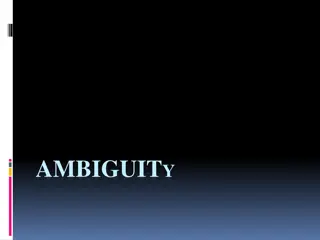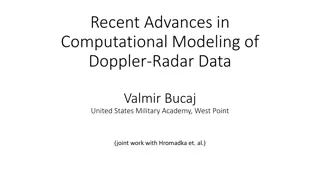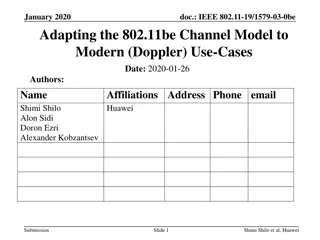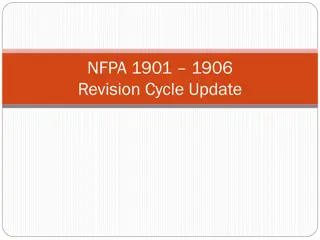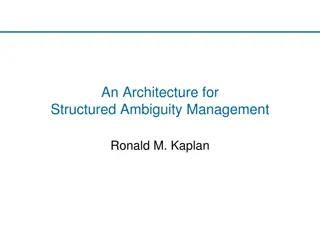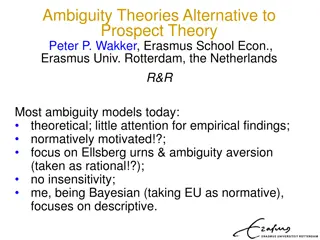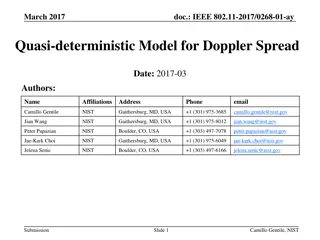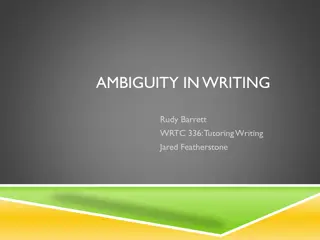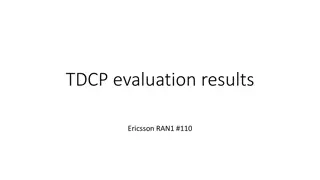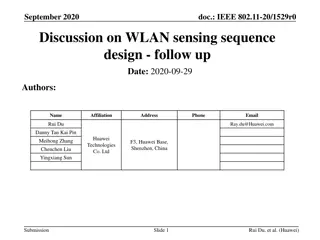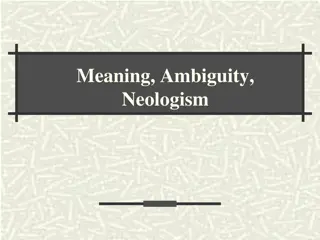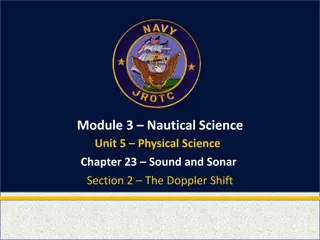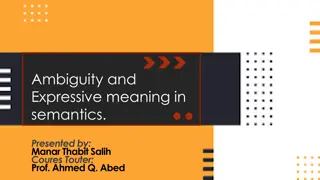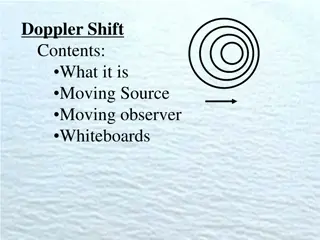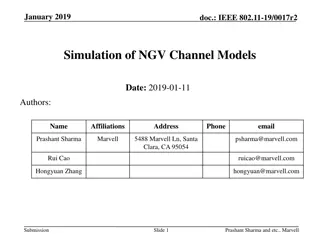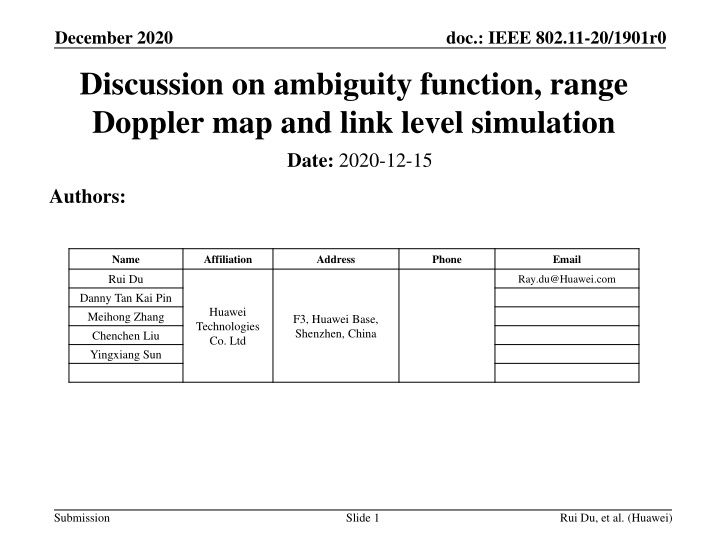
Discussion on Ambiguity Function and Range Doppler Map Relationship
Explore the interconnection between ambiguity function, range Doppler map, and link level simulation in radar waveform design and analysis. Learn about the functions of different types of receivers in generating range Doppler maps and their significance in signal processing. Discover the correlation between range Doppler maps and link level simulation for a comprehensive understanding of radar signal processing.
Download Presentation

Please find below an Image/Link to download the presentation.
The content on the website is provided AS IS for your information and personal use only. It may not be sold, licensed, or shared on other websites without obtaining consent from the author. If you encounter any issues during the download, it is possible that the publisher has removed the file from their server.
You are allowed to download the files provided on this website for personal or commercial use, subject to the condition that they are used lawfully. All files are the property of their respective owners.
The content on the website is provided AS IS for your information and personal use only. It may not be sold, licensed, or shared on other websites without obtaining consent from the author.
E N D
Presentation Transcript
December 2020 doc.: IEEE 802.11-20/1901r0 Discussion on ambiguity function, range Doppler map and link level simulation Date: 2020-12-15 Authors: Name Affiliation Address Phone Email Rui Du Ray.du@Huawei.com Danny Tan Kai Pin Meihong Zhang Chenchen Liu Yingxiang Sun Huawei Technologies Co. Ltd F3, Huawei Base, Shenzhen, China Submission Slide 1 Rui Du, et al. (Huawei)
December 2020 doc.: IEEE 802.11-20/1901r0 Outline Abstract Ambiguity function Range Doppler map The range Doppler map generated with two types of receivers Range Doppler map generated with correlation receiver Link level simulation The information of link level simulation could provide The relationship between range Doppler map and link level simulation Comparison of ambiguity function, range Doppler map and link level simulation Summary References Submission Slide 2 Rui Du, et al. (Huawei)
December 2020 doc.: IEEE 802.11-20/1901r0 Abstract Ambiguity function, micro Doppler map and link level simulation has been discussed in previous presentations[1-3]. In this contribution, the relationship among ambiguity function, range Doppler map and link level simulation is further discussed and presented. Submission Slide 3 Rui Du, et al. (Huawei)
December 2020 doc.: IEEE 802.11-20/1901r0 Ambiguity function Ambiguity function is one of the most important/fundamental tools for radar waveform design and analysis. It is a two-dimensional function of time delay and Doppler shift, showing the output of the received signal through matched filter, and is defined as[4,5] ? ? ? ? ? ????????? ? ?= ? ?,?? Doppler Delay Ambiguity function also indicates the output of a correlation receiver, each row along the delay axis is the correlation result with different Doppler shifts. Submission Slide 4 Rui Du, et al. (Huawei)
December 2020 doc.: IEEE 802.11-20/1901r0 The range Doppler map generated with two types of receivers Correlation receiver and matched filter receiver are two types of receivers could be adopted in sensing to generate range Doppler map. For matched filter receiver, the range Doppler map generated by the receiver is the ambiguity function! If the signal is long enough, range and speed information could be estimated simultaneously. For correlation receiver, fast time, slow time processing is used to generate the range Doppler map. The correlation result of each pulse with different Doppler shift is indicated in the ambiguity function! According the discussion in [3], correlation receiver is more likely to be adopted in WLAN sensing. So, in the following slides of the presentation, the discussion is mainly focused on correlation receiver. Slide 5 Submission Rui Du, et al. (Huawei)
December 2020 doc.: IEEE 802.11-20/1901r0 Range Doppler map generated with correlation receiver Pulse 1 Pulse 2 Pulse 3 Pulse 4 PRI Pulse 1 Correlator Multi pulses/ Slow time Pulse 2 Doppler Pulse Ref Pulse 3 Pulse 4 Range Fast time/range To generate a range Doppler map with correlation receiver, many parameters need to be set as follows. Number of pulses This parameter defines the pulses used for integration, and its maximum value is usually limited by the channel coherent time(CPI). Pulse repetition interval or frequency This parameter limit the maximum Doppler shift could be detected. Target information The range and speed information of target(s) need to be set in order to generate a range Doppler map. For each range Doppler map generated with correlation receiver, one (or more) target(s) is(are) needed. For each individual target, the Doppler component is usually constant during the CPI. It is hard to investigate all the possible Doppler shift in a range Doppler map generated with correlation receiver ! Slide 6 Submission Rui Du, et al. (Huawei)
December 2020 doc.: IEEE 802.11-20/1901r0 Link level simulation The link level simulation proposed in [6]. Transmitter Waveform generation Environment/channel model Channel Target, interference and noise Number of targets Parameters (RCS, delay, velocity, ) Array geometry Element radiation pattern (gain) ERIP Location Indoor Type (new sequence, new waveform, WLAN PPDU, ) Parameters (PRI, BW, fs, duration ) Number of clutter Parameters (reflectivity, delay, AoD, AoA, ) Outdoor Noise Receiver Signal processing and performance evaluation Performance evaluation Parameter estimation Array geometry Element radiation pattern (gain) Array and element errors Location Sampling parameters (fs, duration ) Range estimation Velocity estimation Angle estimation Range accuracy Velocity accuracy Angle accuracy Submission Slide 7 Rui Du, et al. (Huawei)
December 2020 doc.: IEEE 802.11-20/1901r0 The information of link level simulation could provide Sensing performance in different applications scenarios. The results indicates the simulated sensing performance and will be helpful to evaluate the gap between simulated system performance and usage model requirements in different application scenarios. Sensing performance with different signal to noise ratio(SNR). The result provides further insight of the performance with Accuracy vs. SNR results. Sensing performance with different sensing architecture. Monostatic sensing Bistatic sensing Submission Slide 8 Rui Du, et al. (Huawei)
December 2020 doc.: IEEE 802.11-20/1901r0 The relationship between range Doppler map and link level simulation The first step of the link level simulation at the receiver is the generation of range Doppler map. So, some similar parameters are also need to be set, e.g. Number of pulses, Pulse repetition interval or frequency, Target information. But in link level simulation, further processing will be done based on range Doppler map. Detecting the range and Doppler information from the map. Analyzing the error between estimated parameters and ground truth (accuracy). So, the range Doppler map is part the link level simulation. With a few further steps, an end to end link level simulation could be done ! Submission Slide 9 Rui Du, et al. (Huawei)
December 2020 doc.: IEEE 802.11-20/1901r0 Comparison of ambiguity function, range Doppler map and link level simulation Link level simulation Waveform generation and transmitter Signal processing and performance evaluation Receiver Matched filter 1. Sequence/waveform 2. PRF/PRF 3. EIRP 4. Location 5. 1. Gain 2. Location 3. Range Doppler map Performance analysis Channel Detector Correlator In the above figure, the waveform generation, transmitter, channel and receiver are same with the corresponding modules in slide 7. Some details of the signal processing part is shown, correlation receiver could be used to generate the range Doppler map, a detector is adopted to estimate target s parameters, performance analysis is done to evaluation the sensing results. Submission Slide 10 Rui Du, et al. (Huawei)
December 2020 doc.: IEEE 802.11-20/1901r0 Comparison of ambiguity function, range Doppler map and link level simulation Name Pros Cons 1. It is the output of the matched filter receiver, and it compensates the delay and Doppler simultaneously to achieve the maximum output. The 2 D matrix also indicates the correlation result with different Doppler shifts between transmitting signal and receiving signal. It is a fundamental theoretical analysis of sequence/waveforms. 1. High computation complexity. Ambiguity function(range Doppler map generated with matched filter receiver) 2. 3. 1. Similar output with matched filter receiver, but the computation complexity is much lower. Suitable for pulse signal (e.g. the way sequence could be transmitted in the TRN). Suitable to be evaluated in a link level simulation. 1. It is a result with certain Doppler shift and if you want to have a comprehensive analysis with all possible Doppler shifts, many different Doppler shifts are need to be tested. Range Doppler map generated with correlation receiver 2. 3. Link level simulation Range Doppler map (no matter generated with matched filter receiver or correlation receiver) is part of the link level simulation. Accuracy vs. SNR could provide further insight of the sensing performance in different application scenarios and sensing architecture. Submission Slide 11 Rui Du, et al. (Huawei)
December 2020 doc.: IEEE 802.11-20/1901r0 Summary The relationship between ambiguity function, range Doppler map (generated with correlation receiver) and link level simulation is discussed and shown. The ambiguity function is a fundamental theoretical analysis of waveform/sequence. It shows the output of the matched filter receiver and also indicates the output of correlator with different Doppler shifts. The link level simulation is able to investigate the sensing performance in different sensing applications with different sensing architecture. Submission Slide 12 Rui Du, et al. (Huawei)
December 2020 doc.: IEEE 802.11-20/1901r0 References [1] 11-20-1328-00-SENS-discussion-on-wlan-sensing-sequence-design.pptx [2] 11-20-1444-00-SENS-Golay Sequences and Ambiguity Function.pptx [3] 11-20-1529-00-SENS-discussion-on-wlan-sensing-sequence-design-follow-up [4] Skolnik M I. Introduction to radar systems[M]. New York: McGraw-hill, 1980. [5] Mahafza B R. Radar systems analysis and design using MATLAB[M]. CRC pr ess, 2002. [6] 11-20-1642-00-00bf-wlan-sensing-link-level-simulation.pptx Submission Slide 13 Rui Du, et al. (Huawei)



